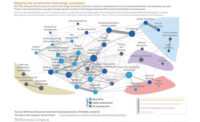
A traffic monitoring system that reads Bluetooth signals from mobile devices inside cars is being implemented around Boston and other cities to predict highway travel times through construction zones and on highways.
The BlueTOAD traffic-monitoring system was created by TrafficCast, Madison, Wis. "It's very, very accurate," says Taylor Stukes, senior engineer of information technology services with KCUS Consulting, Boston. "We're covering roads from Boston to Cape Cod with it, and MassDOT has aggressive expansion planned for the program."
When a vehicle with any Bluetooth device inside drives by a BlueTOAD sensor, the media-access-control (MAC) address of the device is read and time- and location-stamped, says Stukes, whose firm already covers half the state of Massachusetts with the technology. A MAC address is an anonymous, unique identifier used to connect Bluetooth devices to one another. From sensor to sensor, BlueTOAD reads the MAC address and then measures the vehicle's travel time, giving point-to-point data. After the drive-time data goes to a server and a median travel time is computed, MassDOT delivers the data to commuters through a mobile app, says Stukes. Philadelphia also is implementing the system on 21 major roadways for real-time and archival data.
"We need three signals in a 15-minute period, and we need 36 matched pairs in an hour to compute the data," says Karen Jehanian, president of KMJ Consulting, a transportation consulting firm in Ardmore, Pa.
"Like every other state, we used to visually manage traffic with cameras," says Dennis Motiani, assistant commissioner of transportation systems management, NJDOT. He says he is very happy to have real data now. "We get data from E-ZPass readers, from fleets like UPS and now from the Bluetooth sensors," he says. That data is pulled into a data fusion engine that gives an accurate prediction of drive times. Bluetooth sensors fill in the gaps where there are no E-ZPass readers.
"That's the difference between BlueTOAD and E-ZPass," says Jehanian. "This is anonymous, and it is five to 10 times less expensive to deploy but provides the same amount of data." Beyond real-time traffic monitoring, Motiani says the data can be used to make informed construction decisions. "Every time there is a work zone I see how much congestion it causes, so I can know if I can let a crew close a certain lane at a certain hour," he notes.




